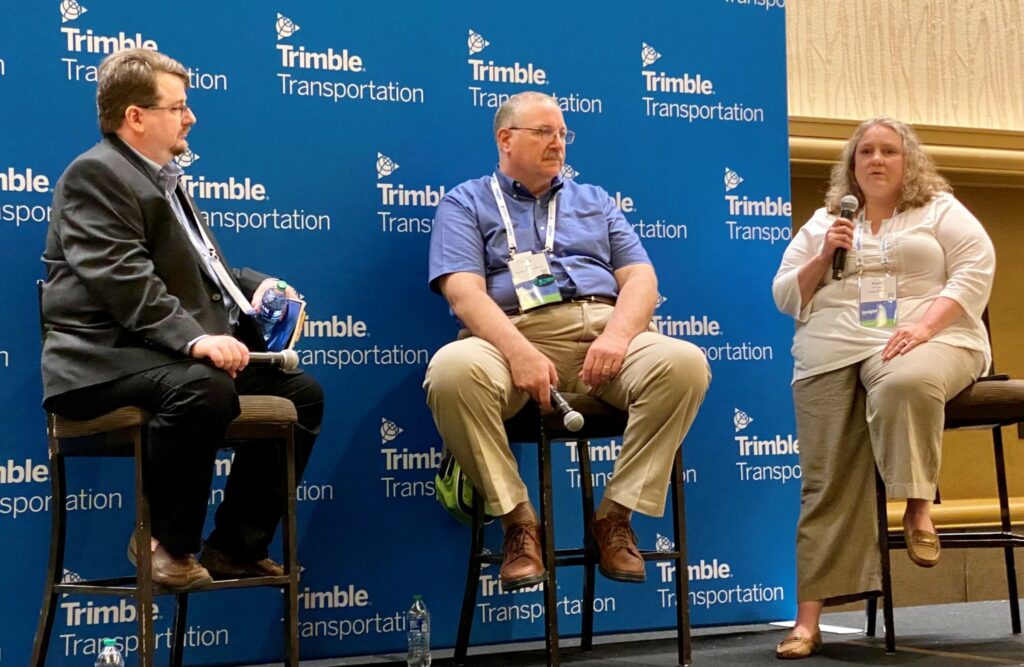Fleets and truck drivers see benefits of AI-powered video, panel says
Video bolstered by artificial intelligence (AI) provides carriers with a full picture – for driver coaching in case of risky behavior, and for exoneration or a quick settlement in the event of a crash.
Trucking industry insiders find that although there has been pushback from drivers over cab-facing cameras due to privacy concerns, there tends to be buy-in once safety benefits are established.
Video cameras can watch road conditions or face the truck interior – monitoring the driver for fatigue, or distractions such as smoking or cellphone use. Data from the cab then helps improve the AI, while machine learning trains computers to analyze videos.

AI is a great safety tool, recognizing things like distraction or fatigue, and setting off an alert telling the driver to pull over and preventing a situation, said Kacy Morales, systems engineer – customer satisfaction at Autozone, during a discussion at Trimble’s Insight Tech User Conference and Expo in Orlando.
She has been pushing for driver-facing cameras and says placing restrictions on who can access the on-demand footage can help overcome hesitancy due to privacy issues, especially with team drivers. “They have a privacy curtain and video is not triggered until there is an event,” she noted.
Distraction and fatigue
Driver behavior can be changed to improve safety, she added, but distraction and fatigue cannot be changed until it is too late.
Terry Henry, system administrator at Shaw Industries, said drivers push back less than some people may think. He compared the situation to the introduction of electronic logbooks. There were worries about drivers leaving the industry in droves when the technology was first mandated in the U.S., but that did not happen.
Today, drivers are used to being on camera. Sometimes it’s even their own equipment. But in those cases, fleets have no control over the videos if the footage is not shared, said Jeff Smith, senior manager of transportation and logistics, Ocean State Jobbers.
If a company has a video solution installed in the truck, the business controls the narrative, and footage of an incident won’t end up on YouTube or TikTok, he added.
Exoneration
Morales said she has pulled up video within minutes of a collision and sent it to officers at the scene to exonerate her company’s drivers. She said drivers who initially thought they were being watched all the time now come in asking to view video of incidents they think were recorded on the road.
Video tells an instant story, and in some cases reduces the need for follow-up investigations.
Smith noted that during coaching sessions in cases of risky behavior, drivers cannot make excuses, reducing push back during the discussions.
Henry gave an example of how another truck hit a four-wheeler that then crashed into his company’s truck, ping-ponging between the two vehicles. He said the car driver thankfully walked away from the crash. Video showed his company’s driver was doing the speed limit and maintaining his lane, and was exonerated.
This kind of footage helps drivers buy into the system, he added.
Have your say
This is a moderated forum. Comments will no longer be published unless they are accompanied by a first and last name and a verifiable email address. (Today's Trucking will not publish or share the email address.) Profane language and content deemed to be libelous, racist, or threatening in nature will not be published under any circumstances.
Outward facing cameras I have no problem with but the Communist big companies that say they can’t get drivers maybe this is the reason watching you employee is like not trusting them and if you don’t trust them you should close your doors do to you can’t trust anyone including yourself.